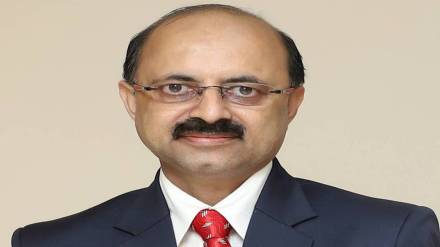UCO Bank is eyeing global M&A opportunities through its overseas branches and upcoming Gift City presence, Managing Director & CEO Ashwani Kumar tells Christina Titus and Mahesh Nayak in an interview. He outlined the bank’s strategic focus on expanding in southern and western India, deepening mid-corporate credit, scaling wealth management, and leveraging new RBI guidelines to actively pursue acquisition financing.
Excerpts:
What were the key takeaways from Q2 results?
Consistent growth across parameters, especially in CASA ratio (maintained at 38%), the turnaround in operating profit and credit growth in RAM (retail, agriculture, MSME) and corporate segments are among key takeaways. The consistent CASA ratio of 38% has underpinned growth amid industry declines. Strategic initiatives like resource verticals, lifecycle-based salary products, PSU API integration, and tab banking (as of September 57% of new accounts are opened) across more than 3,300 branches have boosted high-value account openings. Digital tools like soundbox and QR codes enhance customer stickiness.
What is the bank’s credit growth guidance?
Our credit growth last year was above the target. In the previous two quarters, the credit growth was more than 15-16%. Given the opportunity available, we will surpass the guidance. However, we are not revising the guidance and would like to keep it unchanged at 12-14% for FY26. When the industry is growing at around 11.5%, we do not want to go beyond the reasonable level or basic mark. These are conservative estimates, but we prefer to remain conservative.
What is your guidance on NIM?
We have maintained it at 3.03% (normalised 2.90%) despite RBI repo rate cuts. Our guidance remains at 2.9%, with expectations for improvement once deposits are fully repriced and if no further rate cuts occur.
Which loan segments do you want to focus on going forward?
We are seeing growth across both the RAM and corporate credit portfolios, with RAM expanding at a faster pace. Our focus remains on commercial vehicles and housing loans. In the corporate segment, pricing remains a challenge — many borrowers expect finer rates than we’re comfortable with, which means we occasionally pass on certain opportunities. We are currently focusing on the mid-corporate segment, particularly ticket sizes between Rs 100 crore and Rs 200 crore, where pricing is more favourable, compared to the highly-competitive large corporate space. We are actively lending across sectors that align with our strategic priorities. These include renewable energy, cement, iron & steel, data centres, smart metering, and electric vehicle financing. Given supportive government and RBI policies, I expect strong demand for corporate credit. We aim to maintain our internal mix of 61–63% RAM and 37–39% corporate credit.
What are the growth plans?
This year, we are focused on expanding our footprint by opening 150 branches, particularly across central, western, and southern states, where our presence has relatively been limited. We are also strengthening the wealth management play with a mutual fund and stockbroking platform, exploring direct tie-ups to enhance revenue. We’ve launched a CMS platform, Eterna metal cards, and premium savings products for affluent clients. To deepen engagement and boost fee-based income, trained wealth executives are being deployed in key centres. Our strategy remains partnership-led; we prefer tie-ups for insurance and mutual fund distribution, rather than setting up own subsidiaries.
RBI has allowed acquisition financing by banks. How do you see that? Do you see it as just one added product?
It is a game-changer. We are gearing up to leverage our international presence to actively participate in large-ticket M&As and deals. This presents a significant strategic opportunity for us to expand our global footprint and facilitate cross-border consolidation with enhanced agility and scale. We have two branches overseas in Hong Kong and Singapore. Besides, we have received approval to open a branch in the GIFT city. These three branches will enable us to participate in M&A financing. Overall, M&A financing will be a big opportunity for the public sector banks.
How do you see the impact of ECL on your balance sheet?
We have not gone into micro details of the ECL calculations yet. Our asset quality continues to improve steadily, with slippages well under control at 1.05%, comfortably below our target of 1.25%. Recoveries and upgrades are consistently outpacing slippages, which reinforce the strength of our credit monitoring framework. We have built a robust buffer of around Rs 1,000 crore in provisions, including Rs 530 crore from the COVID era and SMA accounts to cushion future ECL requirements. We will continue to build on this Rs 1,000-crore plus provisions towards our ECL from the next quarter. This ensures that the bank is not burdened by provisioning stress at any single point.
Do you have any fundraising plans in the near term?
We don’t have any plans for this quarter. We will probably go for the fundraising in the next quarter (Jan-Mar). We have got an approval for Rs 2,500 crore for FY26.
There are discussions on stake sale as well as on consolidation of small banks with bigger ones. Is there any update on that?
The government is also working on various alternatives. OFS is also one of the options for the government. Hopefully, it should get through by the time (August 2026). We are all hearing from the media regarding consolidation. However, we have not received any communication from the government. No discussion has happened at all.
How do you view credit deployment trends in the current economy, and which sectors show early signs of revival after GST and income tax reforms?
GST and income tax reforms have boosted consumption by increasing disposable income, reflected in strong vehicle loan demand this season. This uptick is prompting corporates to explore new investments — while smaller capex projects are progressing, larger expansions remain on hold due to tariffs and global uncertainties. Once these ease, the capex cycle should gain momentum.
